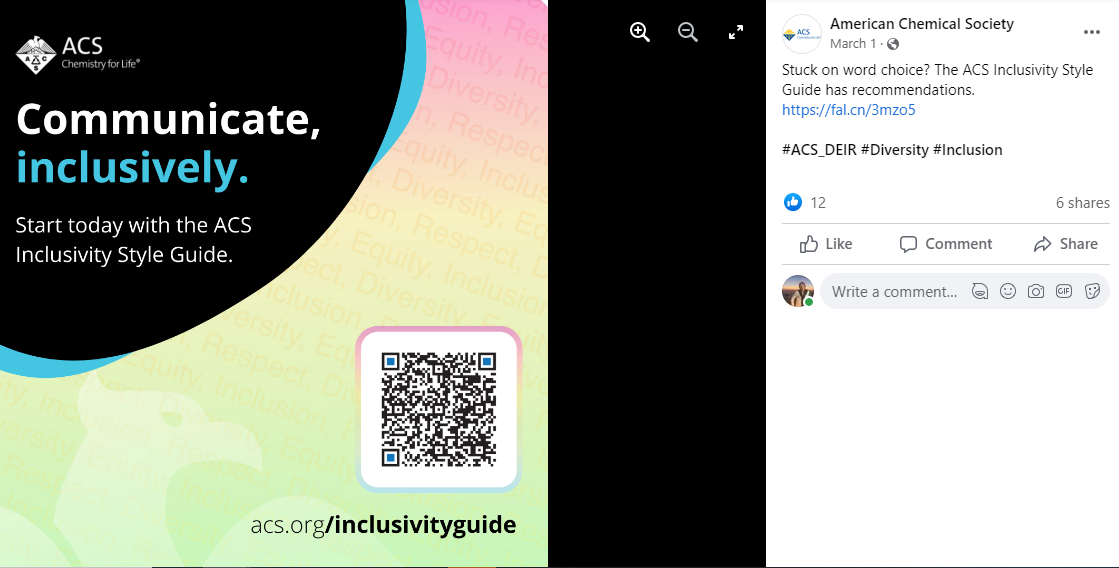|
AM&P Network //Dec. 7, 2022
By Ronn Levine
“Working on this guide and leading the team was a great opportunity for me to meet people beyond my group of Chemical & Engineering News and beyond my division,” said Sabrina Ashwell, senior copyeditor for American Chemical Society, speaking of their ACS Inclusivity Style Guide—an Equity Team Award winner in our Inaugural 2022 IMPACT Awards.
“I really enjoyed making connections to other parts of the organization. There is a group of staff called the Council for DEIR, and that's made up of different people throughout the organizations, and we met with them to talk about the guidelines. So I think it has brought people together and encouraged more collaboration and encouraging people to get feedback from others about how they're communicating.”
Talk about your win-win-win initiatives. The ACS Inclusivity Style Guide offers researched advice on inclusive communication, including language and images and the accessibility of content. It aims to help people ensure their messages treat everyone with respect and avoid alienating or excluding people. There are examples of recommendations in practice, many coming from science publications.
Most importantly, the guide is freely accessible, inside or outside of ACS. And this is a living guide, meaning it may be frequently updated so that it remains relevant and accurate. I spoke with Ashwell more about the guide.
Ronn: ACS is known for taking the lead in so many innovative ways. Can you describe the culture that makes this possible?
How did you decide what is correct? Was it by majority or by going to people of that community? How did that work? Sabrina: It was really important to do research and listen to the people who were going to be described by the guidelines. So we [consulted] the Asian American Journalists Association, the National Association of Black Journalists, the National Association of Hispanic journalists, and the Native American Journalists Association. We went to groups that had existing guides and also groups beyond journalism—but groups that had media guides like the GLAAD media reference guide as one. And there were several others. So looking, doing research to see how people are asking us to refer to them. Sometimes it’s a judgment call, even if you do all this reading, and you try to get a sense of what people prefer. It's important to recognize that not everyone in a group is going to agree on the language to use it. An example is whether to capitalize White. (They do.)
Does the Guide take in these types of discussions? Sabrina: When there are differing opinions, we try to present both sides, and that's why we have a background section. We’ll give our reasoning for why we made a certain recommendation. But the background is also there in case people want to have a different need, or to understand why we made a decision. We do make our history of changes transparent, and that is to allow people to see that this is a living guide, and that language is evolving, and that the guidelines will change over time in terms of specific guidelines that have changed.
Did you ever get together in person? Sabrina: It was all remote. We coordinated via virtual meetings and through collaborative documents like Google Docs to write our drafts and provide comments and using Slack as a way to communicate as well. So the remote collaboration worked very well for us,
Can you describe the process? Sabrina: We first met as a team in late May [2021] and had a first draft by Sept. 30. We started sharing it with the staff and volunteer leaders in December. So it was a pretty fast timeline, and we did a major update earlier this year, where we added a new section and several entries, and we have been making more minor updates throughout the year, and then we'll have another major one by the end of this year,
Last question. Is there a forum for people to say, "Hey, I’m hearing something different now; we may need to change this"? Or is it more just a daily check-in because of the culture there? Sabrina: We set a timeline for when we're going to do reviews—and then do a formal review at least three times a year. And those [key] the big major changes that we'll make throughout the year. We also get feedback through the email address, or just by any other means of email or Slack. And so we have the opportunity to make updates at other points. But the three times a year are when we can continue the process of writing new sections and getting it reviewed by our Council.
Again, here's the link.
|



